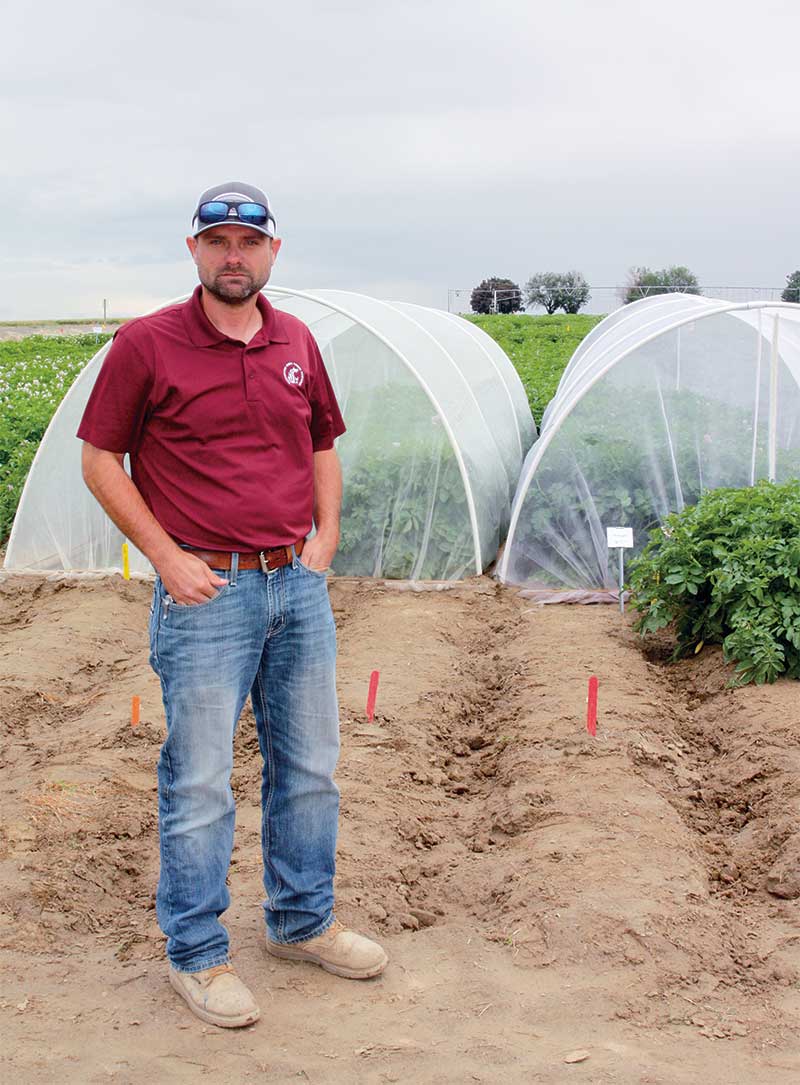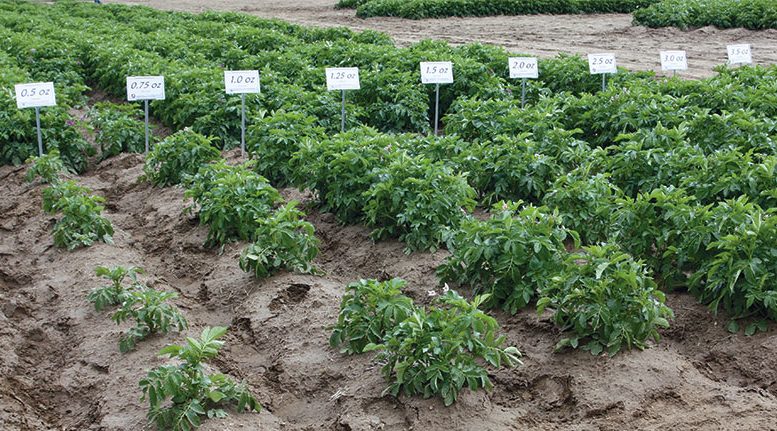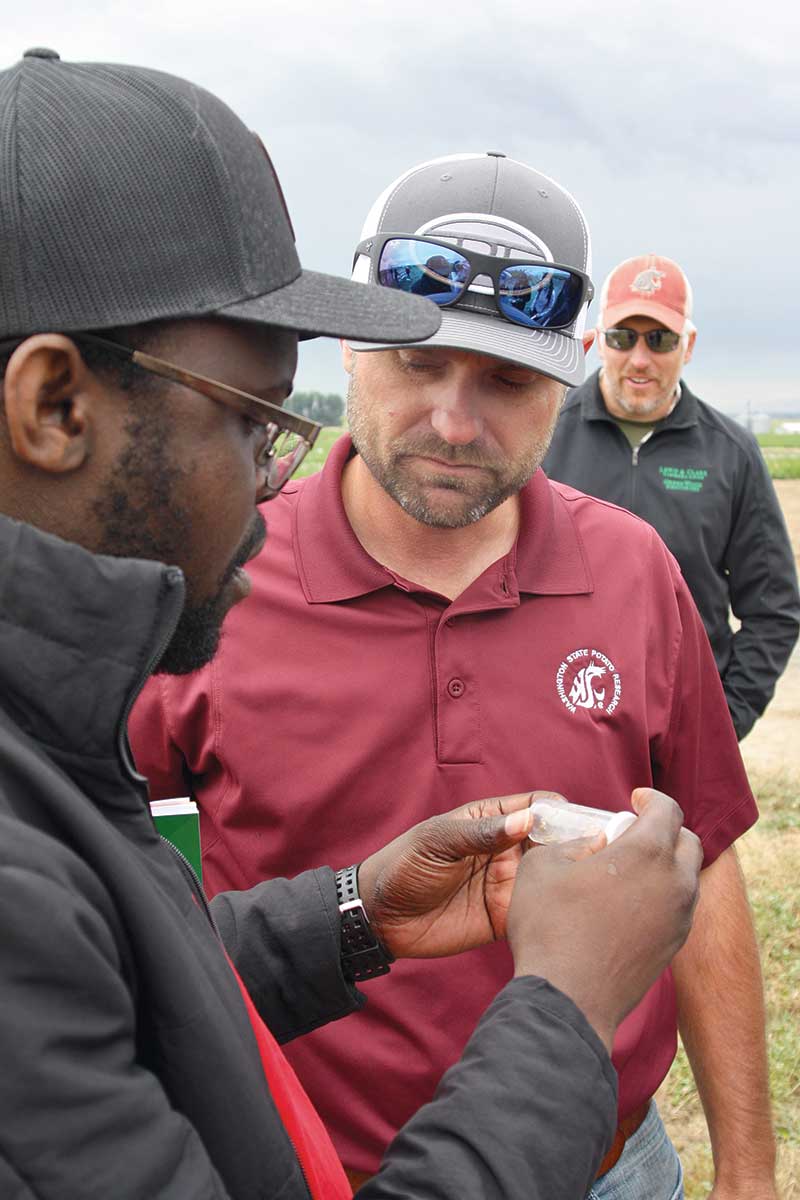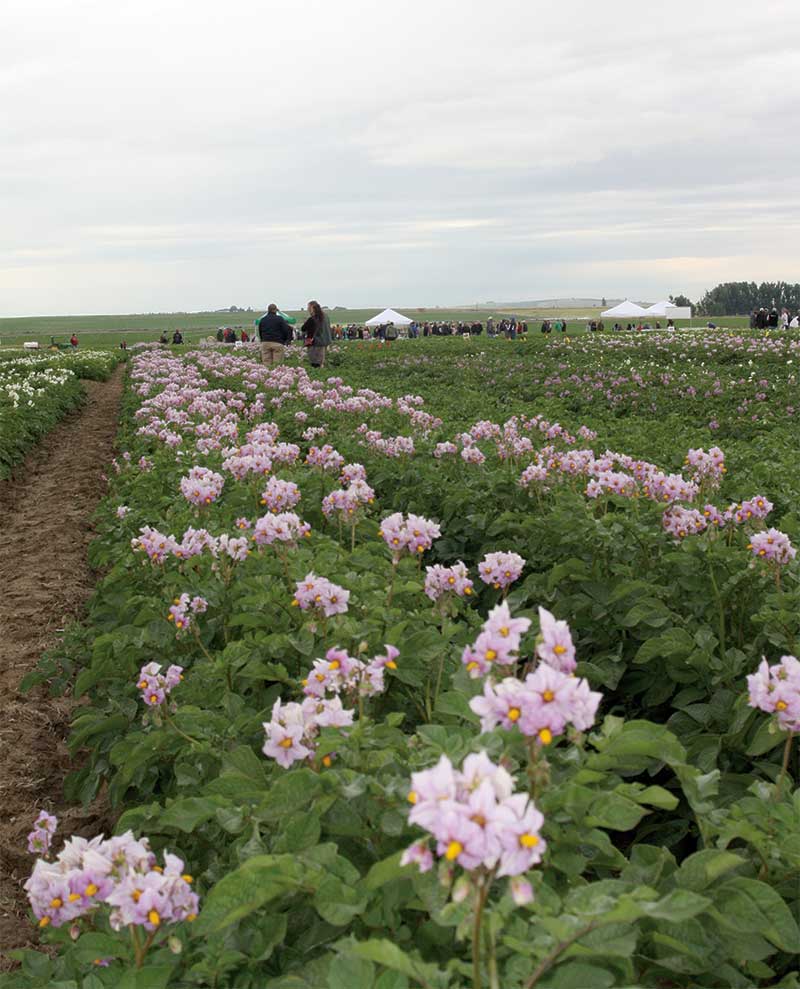Story and photos by Denise Keller, Editor
When does Lygus control matter most?
What seed size makes the most sense?
In ongoing efforts to improve potato production practices, Washington State University (WSU) researchers are working to answer these questions and more. They shared updates on current research projects during the WSU Potato Field Day, held June 27 at the WSU Othello Research Unit.
Lygus Bugs
Lygus bugs continue to be a topic of interest to the potato industry. Tim Waters, a WSU regional vegetable specialist, addressed the industry’s concern about the insect and reported on work being done to determine the best timing for Lygus control. He began by pointing out that it’s important to discern that although Lygus have tested positive for BLTVA, the causal agent of potato purple top disease, they have not been shown to be a vector of BLTVA.
The plant symptomology associated with Lygus feeding resembles purple top because of the way Lygus bugs feed on the plant, Waters said, describing the insect’s mouthpart like a hypodermic needle. It punctures plant tissue, probes multiple places, excretes pre-digestive enzymes and feeds on the plant. When feeding ruptures cells in the phloem and xylem, it disrupts the flow of water and photosynthates in the plant, resulting in purple top type symptomology. This can include malformed leaflets, shortened nodes, swollen nodes and axillary buds. Later, the upper canopy can turn purple and aerial tubers can form.
To learn more, Waters led field trials in 2018, comparing cages infested with Lygus and cages kept free of Lygus. He found that the potato plants in cages infested with Lygus died earlier and showed purple top type symptomology. There was a reduction in soluble solids of tubers, an increase in misshapen tubers and increased greening. The impact on yield was very negligible, but there was a significant reduction in quality.
This year, Waters is repeating the project with a look at the timing of infestation. Because Lygus feed on many different plants, they move into potato fields throughout the year, making control difficult. This year’s trial evaluates infestation at various growth stages in order to determine the most critical time to protect potato plants from Lygus infestation.
“If you wanted to keep Lygus bugs out of your potato fields for the entire season, it would probably cost you $400 an acre to do that and you probably couldn’t do a very good job of it. So it’s not realistic to think we’re going to keep them out of the field the whole season,” Waters explained. “What I’d like to be able to tell you in a couple years is the time to apply insecticides to control Lygus.”
Waters predicts that the research will show later-season control to be more important than control of early infestations because Lygus populations build later in the season and because the insects prefer to feed on flowers in potatoes earlier in the season. He also mentioned that Lygus bugs are more attracted to certain cultivars. Umatilla Russet is more attractive than Russet Burbank, for example.
The next piece of the research will be to determine at what threshold treatment should begin.

Tim Waters, a WSU regional vegetable specialist, is using cages infested with Lygus bugs and cages kept free of Lygus in a research trial to determine the most critical time to protect potato plants from Lygus infestation.
Seed Size
Field day attendees were also interested to hear about Mark Pavek’s latest research project. Pavek, a potato specialist with WSU, is conducting a trial to find the best seed size for Clearwater Russet. The project looks at seed ranging in size from 0.5 to 3.5 ounces. While previous research supports a seed size between 2 and 3 ounces for Russet Burbank, some question whether other varieties such as Clearwater might benefit from larger seed.
At the late-June field day, the trial clearly showed a positive relationship between the size of the seed and the size of the resulting plants. However, Pavek said, the 2-ounce seed may do as well as the larger seed when the cost of seed is taken into consideration.
The researchers will harvest the trial in September and look at yield, tuber size and quality. They will also run an economic analysis.
“As you move up in seed size, you’re paying more for seed. I know seed growers would love to sell more seed, but we also have to keep our commercial growers in business. That’s why we’re going to apply the seed cost to the economic return per acre,” Pavek explained.
Given the strong interest in the project, Pavek plans to expand the trial next year with multiple varieties and include both cut and uncut seed. He will collect at least three years of data before making any recommendations.
Seed Lot Trial
Prior to the research presentations, Pavek invited field day attendees to view the annual seed lot trial. Disease levels were similar to past years, with Potato virus Y (PVY) still prevalent in more than 50 percent of the 280 seed lot samples planted.
Of note in this year’s trial is the decline in non-U.S. developed varieties represented, Pavek said. Between 2013 and 2018, the number of non-U.S. developed potato variety seed lots entered in the trial increased steadily. However, this year that number declined 72 percent from last year. The 2019 seed trial included only 11 non-U.S. developed potato varieties, accounting for 4 percent of all seed lots entered in the trial.
Varieties developed by the Northwest Potato Variety Development Program/PVMI accounted for 56 percent of the seed lots entered in the 2019 trial. Those varieties included Alturas, Castle Russet, Clearwater Russet, Highland Russet, Mountain Gem Russet, Modoc, Payette Russet, Ranger Russet, Umatilla Russet and Yukon Gem.
Pavek mentioned that the most significant change in the Washington seed lot profile in the past 50-plus years has been the increase in the number of varieties Washington growers are planting. In 1962, eight varieties were entered in the seed lot trial; in 2019, there were 38.




